Last year we realised our wish to stay in Hiroshima for a few days, inspired by our day trip during our honeymoon. As I mentioned in my post about meeting a Hibakusha, we stayed at the World Friendship Center, west of the city centre, in a quiet residential area.
The Center is lovely, tucked away down a side street, next to the Tenmagawa river. Our room was simple, with two futon laid out on the floor and a small balcony. We were in the main building, where there was a lounge area for guests to read books about the effects of the A-Bomb on Hiroshima, or sit and chat with the volunteer Directors, Larry and Jo-Ann, or each other. After we had arrived and unpacked, we were invited by Larry to add a push pin to the map on the wall, to show where we had travelled from. The map was very full of pins and it was hard to squeeze ours on there. Larry talked about possibly getting another map, or a series of maps.
Breakfast is provided, but no other meals. Both Jo-Ann and Larry were very helpful in recommending places for us to eat. Larry had a passion for local delicacy okonomiyaki and recommended the bar on the corner up the street from the center as being vegetarian friendly.
We had most of the afternoon still ahead of us when we arrived, and Larry loaned us the Center’s copy of the guide book used by the organisation’s volunteer guides so that we could do a self-guided tour around the Peace Memorial Park. We had visited the park on our visit in 2009, but having the guide book made such a difference. The book provided lots of background information, and I wish that I’d been able to buy a copy.
As well as seeing familiar monuments such as the Memorial Cenotaph, where a register of names of everyone who has died as a result of the A-Bomb is kept, with new names added every year, the Peace Flame that will burn until all nuclear weapons have been destroyed, and the Children’s Memorial to Sadako Sasaki, we also found monuments that we had missed before.
The most interesting one for me was the memorial to the children who had been mobilised to do war work, because there were not enough adults, and had been killed by the bomb while working. We hadn’t met Komeyoshi Kiyoko-san yet, but she was a mobilised student who survived. It was sobering to think that Japanese people’s loyalty to the Emperor and the cause of war was so strong that even their children played a direct part in the war effort. Another reminder of how Japanese culture and society differs from my own.
Hiroshima presents itself as a city of peace, and understandably you can’t avoid the reminders of the effects of the atomic bomb on the city. While we were out shopping the next day, we came upon the Hiroshima branch of the Bank of Japan. Its exterior had survived the bomb blast because of the thickness of its stone walls, but the heat from the blast destroyed its mainly wood interior and killed everyone who was inside the building. The exterior looks completely unscathed. I found it quite surreal, especially when I read on the information panel that only a few days after the bomb was dropped, the residents of the city set up a temporary banking facility inside the building so that life could continue as normally as possible.
I enjoyed shopping in the city. It feels more laid back than Tokyo, and funkier than Kyoto. It has its own style, and the residents are very friendly. We were looking for a new vegan café, Shanti, on one of our shopping trips, trying to make sense of yet another Japanese map that skimps on street names and sense of scale, when an older lady walking past stopped to ask if we needed help. I pointed to the name of the café on the map, and she said that we were on the right street. All three of us looked up and down the street, trying to spot the café. Eventually, she took the map from me, dashed into a nearby shop and returned with directions. We thanked her and she went on her way. Unfortunately for us, we still couldn’t find the café! Luck, or kindness, was on our side, though, because the shop assistant that the lady had asked was watching from the doorway and saw us walk past the entrance to the café. He ran out, calling to us and pointing at the doorway. I am often grateful for small kindnesses when we are travelling in Japan!
The food in Shanti was delicious. I had the deli set, which was two omusubi (おむすび) rice balls, soup, salad, three dishes from the deli counter and a drink, all for 1000円. I chose the tofu hamburg steak, the bean salad and the veggies in miso, with hibiscus tea. It felt so good to be eating so much veg! And all of the produce used in the café is locally grown. Highly recommended, whether you’re vegan, vegetarian or a meat eater.
A new place we visited on this trip was Shukkeien Garden. We went there after we had listened to Kiyoko-san’s story, and it was lovely to be somewhere so tranquil. The garden is beautiful. Originally built in the 1600s, it was destroyed by the atomic bomb. Its importance to the people of Hiroshima, though, led to the Hiroshima Prefectural Board of Education restoring it to its original form in 1951. It is designed as a stroll garden, and the features represent natural forms and scenic views in miniature. We had an hour before it was due to close for the day, and I could have spent a lot longer strolling around, sitting and contemplating the views.
Someone was having their wedding photographs taken while we were strolling round, as well – what a perfect location!
This visit we also went to the Peace Memorial Museum. I found this a very moving experience. The ground floor of the entrance building sets the context of the war and explains the lead up to Japan’s involvement, and the decisions made by the Allied powers in deciding where to drop the first atomic bombs. It was quite chilling to read the matter of fact logic behind the choices of Hiroshima and Nagasaki. It doesn’t shy away from Japan’s actions in the war, and doesn’t take a nationalistic, Japanese position. The first floor explores the development of nuclear weapons and their effects. I found the way information was delivered very factual and balanced, almost impersonal, in the entrance building. The main building was something else, though, something very important. It consists of a long room full of the personal possessions of people killed by the bomb, either directly or a couple of days or even years later. These possessions are interspersed with pieces of buildings damaged by the blast, melted household goods, charred lunch boxes and, finally, a display of some of the paper cranes folded by Sadako Sasaki along with some of her belongings.
As you exit the final room, you emerge onto a long corridor that overlooks the Peace Memorial Park. There are benches where you can sit and reflect on what you’ve just seen, so we did. I found the last section of the museum quite hard. It made me sad for the people who had been killed or had lost loved ones, and angry that people don’t really understand how personal nuclear weapons are. One thing that really made me angry, though, was the attitude of some of the other visitors to the museum. At one point, a man called back to others in his party to come and look at some of the human remains that are on display, so that they could laugh at how gruesome they were. It disgusted me that someone could be so unaffected by what was around them, and could behave so childishly.
A happier experience was Organza, a café recommended to me by my friend Chloe. She had described it as crackers, and she wasn’t wrong. It’s part music venue, part café run by someone at the heart of Hiroshima’s underground music scene, and it is utterly bonkers. There are odd things all over the place. We had a sort of afternoon tea in a booth underneath a balcony that felt like we were in a captain’s cabin on an old ship. Around us were curiosities such as a stuffed owl, a stag’s head and an angel, and strange paintings of fish drinking wine.
If you’re in Hiroshima and fancy somewhere a bit off the wall, where you’ll hear good music and maybe catch a local band, then Organza could be the place for you.
Of course, no trip to Hiroshima is complete without a boat ride across the bay to Miyajima, but I’m saving that for another post. I’m ending my whirlwind tour of Hiroshima here. We were there for four days and we certainly packed a lot in. There are still areas that I would like to explore, out to the west of the city and further up the coast, but four days felt about right for Hiroshima itself.
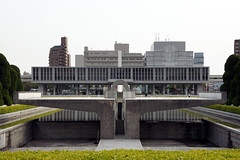
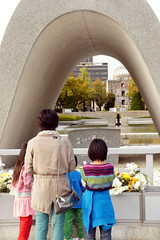
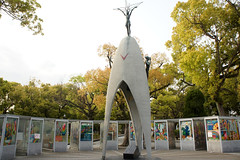

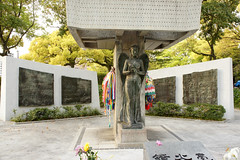
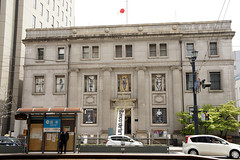
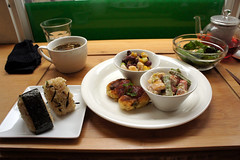
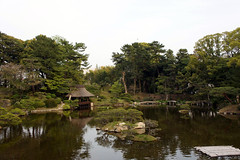




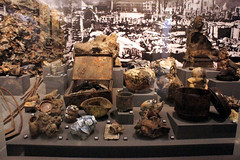
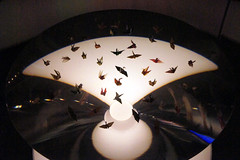
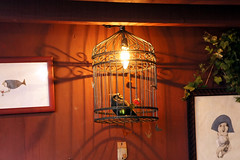

Posted by Aomori City (青森市) | Japanophile on 30/07/2014 at 1:22 pm
[…] have focused on the stretch of Honshu that runs between Hiroshima and Tokyo. We have stayed in Hiroshima, Osaka, Kyoto, Kamakura, Kawaguchiko and Tokyo. We have visited Miyajima, Uji, Nara, Enoshima and […]
Posted by My Japan Guide | Japanophile on 03/11/2014 at 1:34 pm
[…] only done a day trip to Hiroshima so far. We’ve now stayed in Hiroshima for a few days and seen more of the sites, including Miyajima and the Peace Memorial Museum. I love […]
Posted by Shimanami Kaido/しまなみ海道 | Japanophile on 17/08/2015 at 5:33 pm
[…] I’m glad that we didn’t. I’m viewing it as a test run. My new plan is to stay in Hiroshima again and catch the train to Onomichi, from where we’ll take a full day to cycle the […]